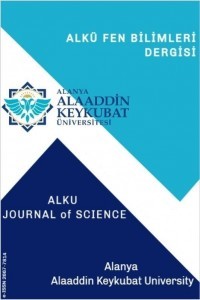Pirinç Kabuğu Külü Katkılı Harçların Dayanım Ve Dayanıklılık Özelliklerin Araştırılması
Bu çalışmada, tarımsal atık malzemesi olan Pirinç kabuğu külü, çimento yerine ağırlıkça %0, %2, 4%, 6%, 8%, 10%, ve %15 oranlarda kullanılarak toplam 7 farklı bileşime sahip harç numunesi üretilmiştir. Üretilen harç numuneleri üzerinde 28, 56 ve 90 günlük kür süreleri sonunda basınç dayanımı tespitinin yanında 56 günlük kür sonunda donma-çözülme ve ultrasonik hız tayini deneyleri de yapılmıştır. Çalışmada kullanılan bütün karışımlarda Su/Bağlayıcı oranı 0.50 oranında sabit tutulmuştur. Üretilen harç numunelerine ait sonuçlar değerlendirildiğinde %8 Pirinç kabuğu külü ikameli harçların daha yüksek dayanım ve dayanıklılık sonuçları verdiği tespit edilmiştir.
Anahtar Kelimeler:
Pirinç kabuğu külü, Dayanıklılık, Dayanım
Investigation of Strength and Durability Properties of Mortars with Rice Husk Ash Additive
In this study, a total of 7 different composition mortar samples were produced by using Rice husk ash, which is an agricultural waste material, instead of Cement at 0%, 2%, 4%, 6%, 8%, 10% and 15% by weight. Freezing-thawing and Ultrasonic velocity determination experiments were performed on the produced mortar samples as well as the compressive strength determination at the end of the curing periods of 28, 56 and 90 days. Water/Binder ratio was kept constant at 0.50 in all mixtures used in the study. When the results of the mortar samples were evaluated, it was determined that the mortars with 8% Rice husk ash substitution gave higher strength and durability results.
Keywords:
Rice husk ash, Strength, Durability,
___
- [1] Zhao L, Yi D, Fei W, Zhi P. “Thermal insulation material based on SiO2 aerogel”. Construction and Building Materials, 122, 548-555, 2016.
- [2] Ernst W, Lynn P, Nathan M, Chris H, Leticia O. “Carbon Dioxide Emissions from The Global Cement Industry”. Annual Review of Energy and The Environment, 26, 303-329, 2001.
- [3] Nur R, Studi A. “Design of Portland Cement Factory with Waste Paper Sludge Ash as an Alternative Raw Material”. Journal of Civil Engineering, 4 (2), 2337-3539, 2015.
- [4] Schneide M, Romer M, Tschudin M, Bolio H. “Sustainable cement production – present and future”. Cementand Concrete Research, 41, 2642–650, 2011.
- [5] Alex J, Dhanalakshimi J, Ambedkar B. “Experimental investigation on rice husk ash as cement replacement on concrete production”. Construction and Building Materials, 127, 353–362, 2016.
- [6] Brown T, Gambhir J, Florin N, Fennell P. “Reducing CO2 Emissions from Heavy Industry: A Review of Technologies and Considerations for Policy Makers”. Imperial College London, South Kensington, London, United Kingdom, 7, 1-32, 2012.
- [7] Roy DM. “Alkali-activated cements opportunities and challenges”. Cement and Concrete Research, 29(2), 249–254, 1999.
- [8] Talling B, Brandsteter J. “Present state and future of alkali-activated slag concretes”. American Concrete Institute, 114, 1519–1546, 1989.
- [9] Kazmi SMS, Abbas S, Munir MJ, Khitab A. “Exploratory study on the effect of waste rice husk and sugarcane bagasse ashes in burnt clay bricks”. Journal of Building Engineering, 7, 372–378, 2016.
- [10] Cheah CB, Part WK, Ramli M. “The long-term engineering properties of cementless building block work containing large volume of wood ash and coal fly ash”. Construction and Building Materials, 143, 522–536, 2017. [11] Swamy RN. “High performance and durability through design”. American Concrete Institute, 159, 209–230, 1994.
- [12] Smith IA. “The design of fly ash concretes”. Proceedings of the Institution of Civil Engineers, 36(4), 769–790, 1967.
- [13] Rizwan SA. High performance mortars and concretes using secondary raw materials. PhD Thesis, Technical University of Bergakademie, Freiberg, Germany, 2006.
- [14] Kamiya K, Oka A, Nasu H, Hashimoto T. “Comparative study of structure of silica gels from different sources”. Journal of Sol-Gel Science and Technology, 19, 495–499, 2000.
- [15] Coutinho JS. “The combined benefits of CPF and rice husk ash improving the durability of concrete structures”. Cement and Concrete Composites, 25(1), 51–59, 2003.
- [16] Zhang MH, Malhotra VM. “High-performance concrete incorporating rice husk ash as a supplementary cementing material”. ACI Materials Journal, 93(6), 629–36, 1996.
- [17] Yalcin, N., and Sevinc, V., “Studies on silica obtained from rice husk”, Ceramics International, vol. 27, no. 2, pp. 219-224, 2001.
- [18] Bakar RA, Yahya R, Gan SN. Production of high purity amorphous silica from rice husk. Procedia Chemistry 2016; 19: 189-195. doi: 10.1016/j.proche.2016.03.092
- [19] Kalapathy U, Proctor A, Shultz J. A simple method for production of pure silica from rice hull ash. Bioresource Technology 2000; 73 (3): 257-262. doi: 10.1016/S0960-8524(99)00127-3
- [20] TS EN 197-1. “Çimento-Bölüm 1: Genel Çimentolar-Bileşim, Özellikler ve Uygunluk Kriterleri”. Türk Standartları Enstitüsü, Ankara, Türkiye, 2012.
- [21] TS EN 196-1 “Çimento Deney Metotları – Bölüm 1: Dayanım Tayini”. Türk Standartları Enstitüsü, Ankara, Türkiye, 2009.
- [22] ASTM International. “Standard Test Method for Resistance of Concrete to Rapid Freezing and Thawing”. West Conshohocken, PA, USA, ASTM C666/C666M-15, 2015.
- [23] Erdoğan TY. Beton. Ankara, Türkiye, ODTÜ Geliştirme Vakfı Yayıncılık ve İletişim AŞ. Yayını, 2003.
- Yayın Aralığı: Yılda 3 Sayı
- Başlangıç: 2019
- Yayıncı: Alanya Alaaddin Keykubat Üniversitesi
Sayıdaki Diğer Makaleler
Doğaltaş Üretim ve İşleme Tesis Atıklarının Değerlendirilmesi
COBALT BORİD KATALİZÖRLERİ İLE SODYUM BOROHİDRİTTEN HİDROJEN ÜRETİMİ
Sevim YOLCULAR KARAOĞLU, Serdar KARAOĞLU
EFFECT OF FLY ASH AND ITS CURING TIME ON SPECIFICATION OF FLY ASH – SILTY SOIL MIXTURE
Kaveh DEHGHANİAN, Najibullah AYAR
Pirinç Kabuğu Külü Katkılı Harçların Dayanım Ve Dayanıklılık Özelliklerin Araştırılması
Sivas İlindeki Bir Bina İçin Enerji Simülasyonunun Uygulanması
